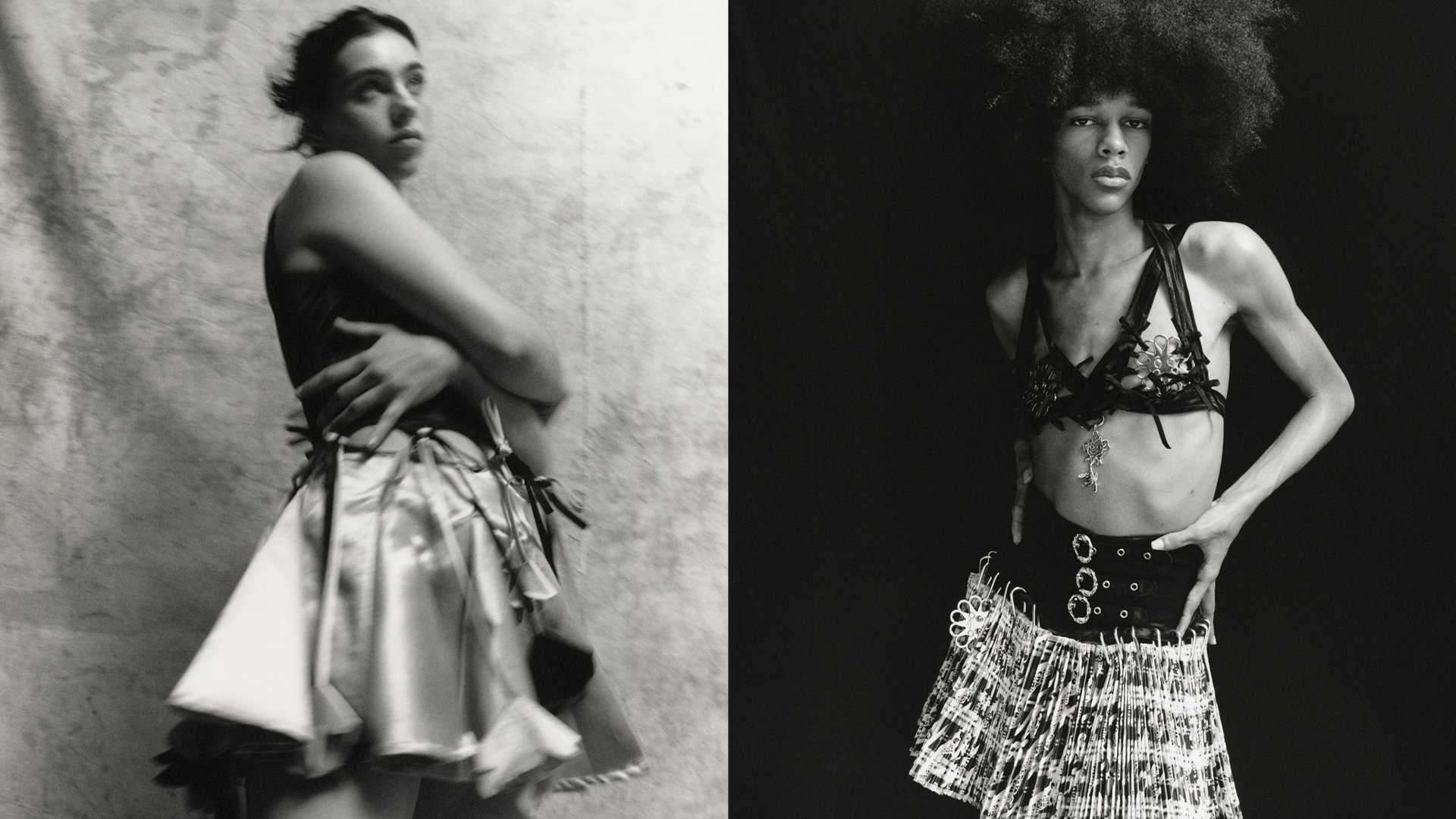This story originally appeared in i-D’s The Timeless Issue, no. 371, Spring 2023. Order your copy here.
If you are a contemporary fashion acolyte with internet access, there is little chance that you are not familiar with Chopova Lowena. Even if not by name, their polychrome pleated skirts, marbled denim jeans, flocked-floral Victoriana gowns and objet- trouvé necklaces are hardly the sort of pieces that sink into the back of your mind once seen. Outré as it all may seem, though, it’s exactly this distinct eclecticism — the innovative blur of a mind boggling yet incredibly precise array of motifs — that has fuelled the brand’s cult appeal.
The world that Emma Chopova and Laura Lowena-Irons have created since founding their label in 2017 is a generous one. With its panoply of references and aesthetic tones, there is invariably something in their work that will resonate; an entry point that feels like it has been created just for you. One of the brand’s hot-ticket skirts, for example — with its pleated gathers of upcycled tartan tablecloths and vintage Bulgarian wall hangings — will trigger a Proustian recollection of a girlish school skirt for some, a punk-era Westwood kilt to others. It exemplifies the girls’ deliciously Frankensteinian approach — their yen for defamiliarising clothes that have long been part of fashion’s repertoire by piling trinkets, doodles, gizmos and clashing components onto otherwise recognisable pieces.
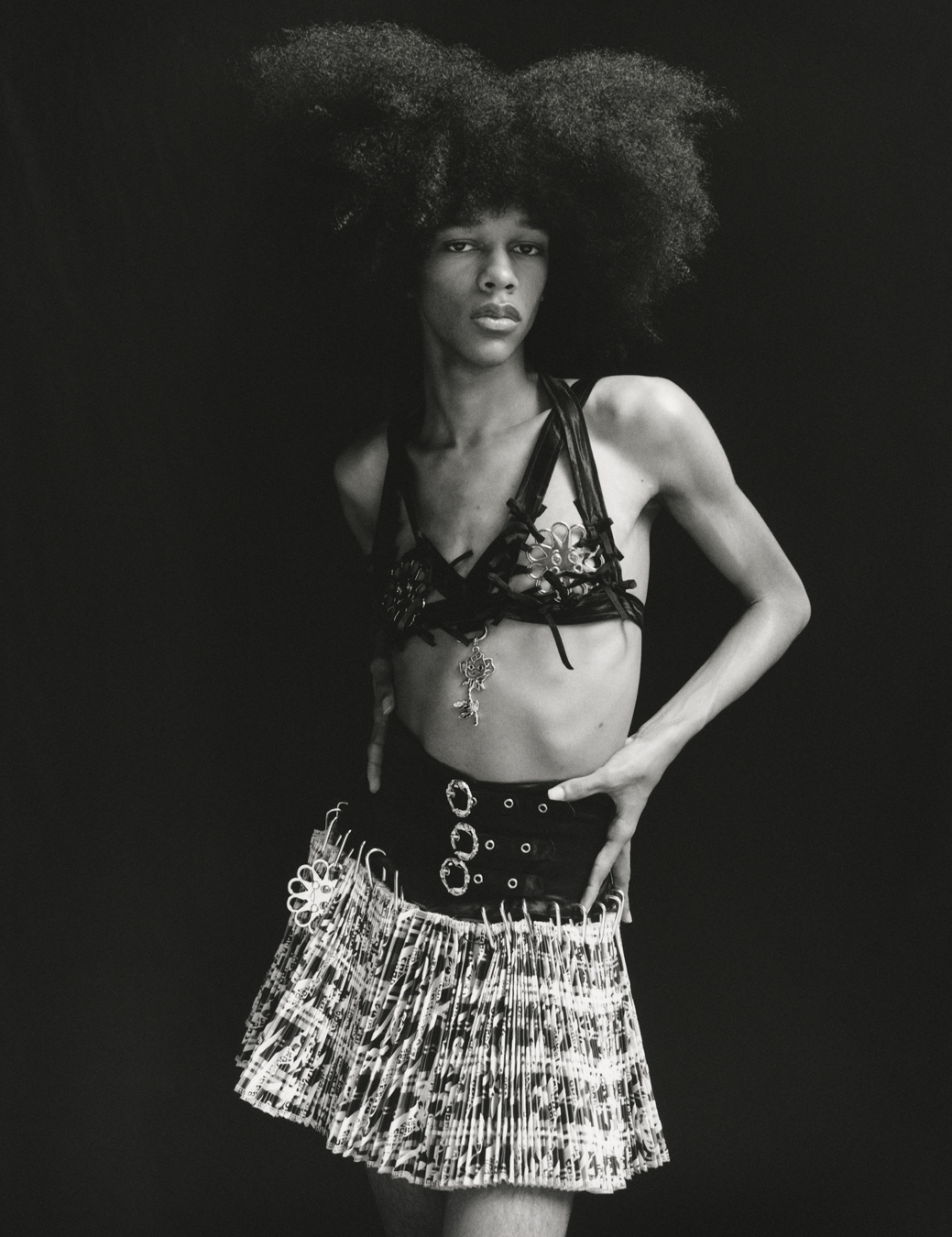
The range of perspectives in their garments is a natural consequence of the contrasts between the label’s two founding designers. “Laura has always gravitated towards art and more conceptual things, whereas I just really love product design. And Laura loves colour, whereas I don’t so much,” Emma says, “but that’s then why we offer the black dresses with all the metal details,” counterbalancing the brand’s pinwheel folklorism and ravey exuberance with a grungy, emo-y timbre. “There’s always a balance we strive for.”
Granted, that balance wasn’t always a given. It certainly wasn’t when they first crossed paths — which, for the record, was as the first (or second, Laura demurs) people to speak to one another on the first day of their BAs at Central Saint Martins. Though their professional meet-cute rings of a mystical sense that it was always meant to be, it would be remiss to imply that the two designers wafted down a preordained path to the status they now enjoy. Rather, their story has been characterised by the lengthy exploration of one another’s differences to achieve the near-antagonistically maximalist, carabiner-clipped look they are now known for, and by their adamant determination in bringing it to the world’s stage.
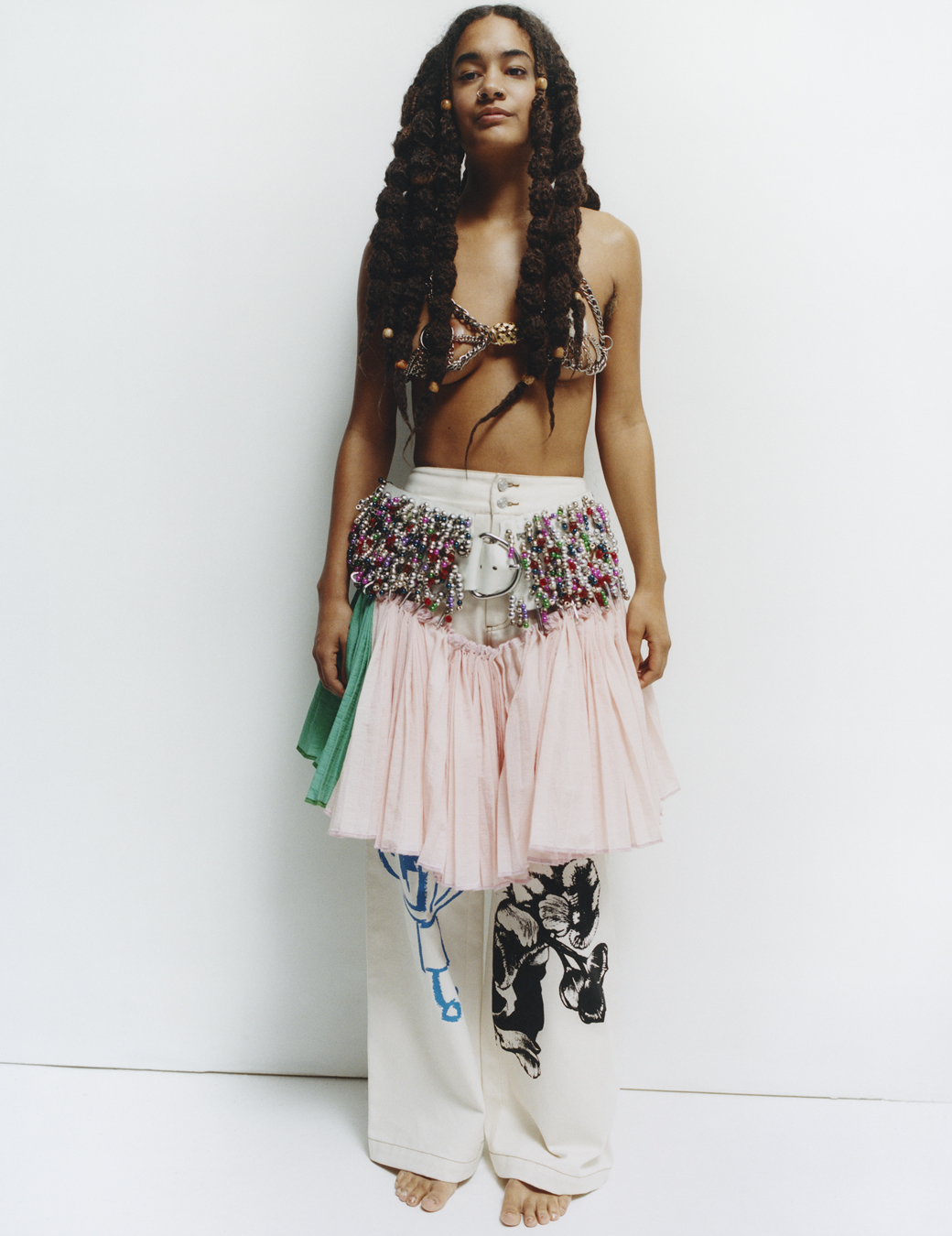
“There was always some overlap in terms of what we both liked, but we were also those people at school that didn’t really know what we were into, Laura says. “We knew that we wanted to develop a really strong aesthetic and, deep down, knew that it wasn’t going to be mine or Emma’s aesthetic, but rather something new that would develop from both of us. Later, over the course of our MA at CSM” — on which they enrolled as a pair, only the second ever to do so — “we explored and changed so much, and eventually figured out what made us different, and how we could create that.”
It was in the summer between the first and second years of their joint MA that the seeds for the Chopova Lowena aesthetic were first sown, blooming from the words “acidic, rave and folklore”, Laura says. Their resulting graduate collection — replete with asymmetric swathes of bright, checked fabrics, exploded sleeve volumes, sporty lycra undergarments, climbing carabiners and yards of rope — struck an off-beat harmony between folkloric romanticism, punky grit, and dynamic sportiness: qualities that are at the core of the brand’s look today.
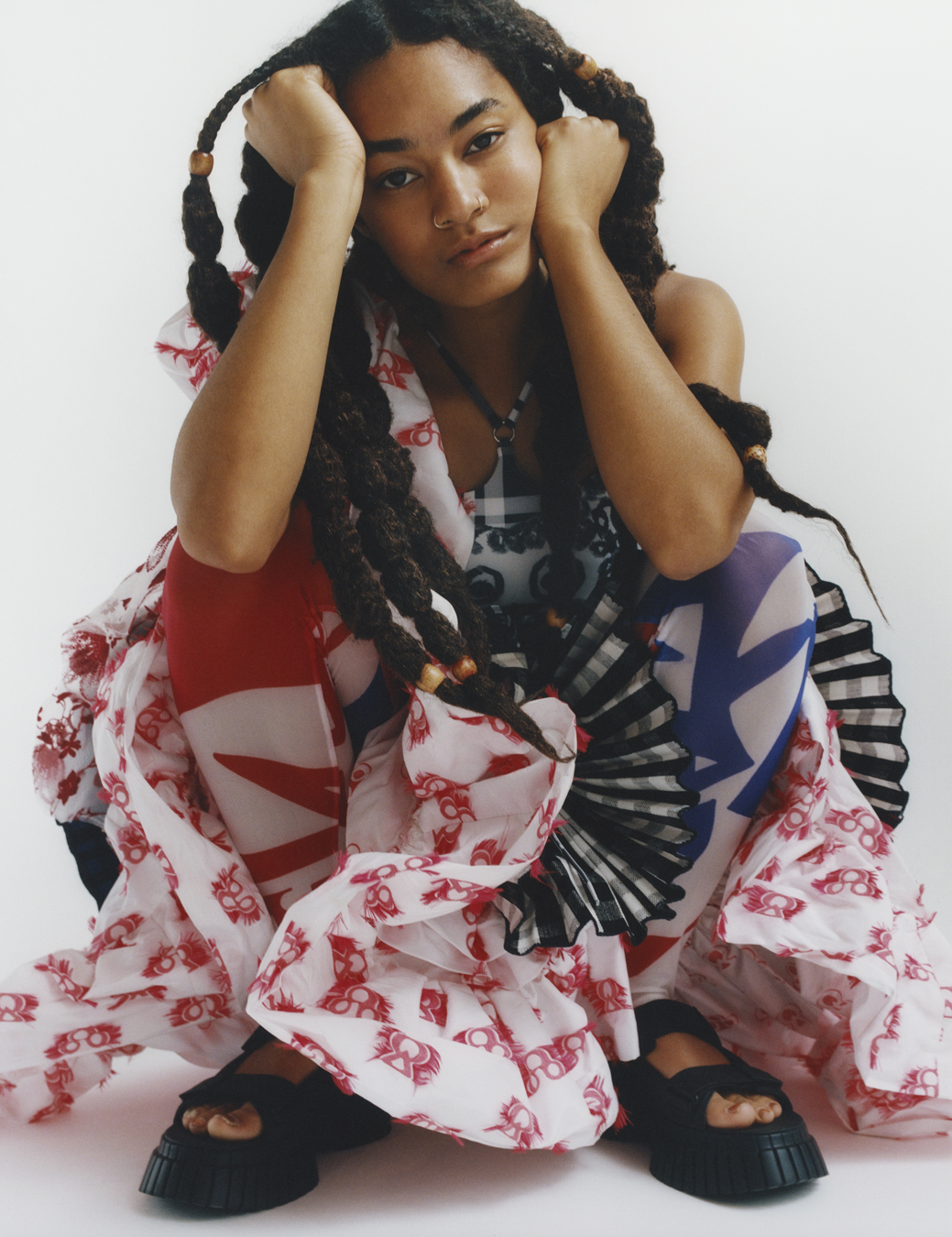
Having settled their intentions of founding their brand on leaving the MA, the girls left Granary Square with hopes of pursuing what many London based young designers consider the yellow brick road to success: following the pathway of support schemes like Fashion East and the British Fashion Council’s NEWGEN programme. This, however, was not in store — much to Emma and Laura’s despair at the time. “To be honest, during our first year after the MA, it was really crushing to not get access to certain platforms, and we applied a few times over,” Emma says. “We thought we’d do the CSM MA show, and then gain access to all of these things, but the reality is that you have to find your own path. You don’t get told that at uni — you come out, you don’t know how to run a business, and you just have to figure it out,” Laura concurs. “What was really difficult, on a mental level, was facing up to how hard it is to get people to believe in what we were doing,” Emma adds.
Of course, there were those that did. A major turning point came with the feverish uptake of their signature skirts, which have since earned the sort of grail status usually reserved for cult handbags and sneakers. A cipher for Emma and Laura’s design logic and approach, the step-hemmed kilt-like pieces quickly became a favourite of seemingly every fashion-forward celebrity, influencer, and street style star about a year after Emma and Laura set up shop. While it may have felt like a flurry of punky pleats appeared on your screens overnight, on the designer’s end, “it was a pretty slow burn,” Emma says. “It was all simply because Natalie Kingham – Matchesfashion’s former buying director — picked up the skirt first and was like, ‘Make us 30 of these, please!’, and then they sold out within a day,” Laura recalls. “And even though that was so exciting, in our showroom, they were like ‘This skirt isn’t gonna be the thing, you need to think of something else,’” Emma adds. “It wasn’t until we started seeing people wearing them to events that we realised that people really liked them, and that we had made this cult product.”

Though pinning down what exactly people see in Chopova Lowena is tricky. A common factor is invariably the ability to appeal to everyone’s inner weirdo. They create clothes that are self-assured in their off-kilter nature, but still feel like proper, plausible fashion; clothes for schoolyard outcasts who grew up to be the most interesting people in whichever room they walked into. “We definitely design with that outsiderness in mind, and I think that’s because that’s who we’ve always been,” Emma says, recalling her high school tumults. Having migrated from Bulgaria to suburban New Jersey at the age of seven, she notes the sense of placeless-ness that marked her adolescence. “My family and I didn’t fit in, we weren’t accepted. We didn’t know what to say or what to wear, what to do to fit in. And I think that I struggled with a loss of identity, because I didn’t really feel like I was from anywhere anymore. My teen years were spent trying to figure that out. I went through every single fashion phase possible, and from like thirteen onwards, I was friends with five different groups that were all aesthetically different, from preppy to emo. I did every single aesthetic pretty damn hard.”
Though distinct, Laura’s experience of schoolyard marginality came upon moving schools at the age of fifteen, going “from a high school where I was really comfortable, had loads of friends, and was in all the sports teams” to a new one where she was the designated ‘new girl’ — “and all the popular kids were so awful! So I guess we just started out designing for each other in a way, as we are those outsider kids that have now grown up,” she says, “but it’s not just about me and Emma anymore.”
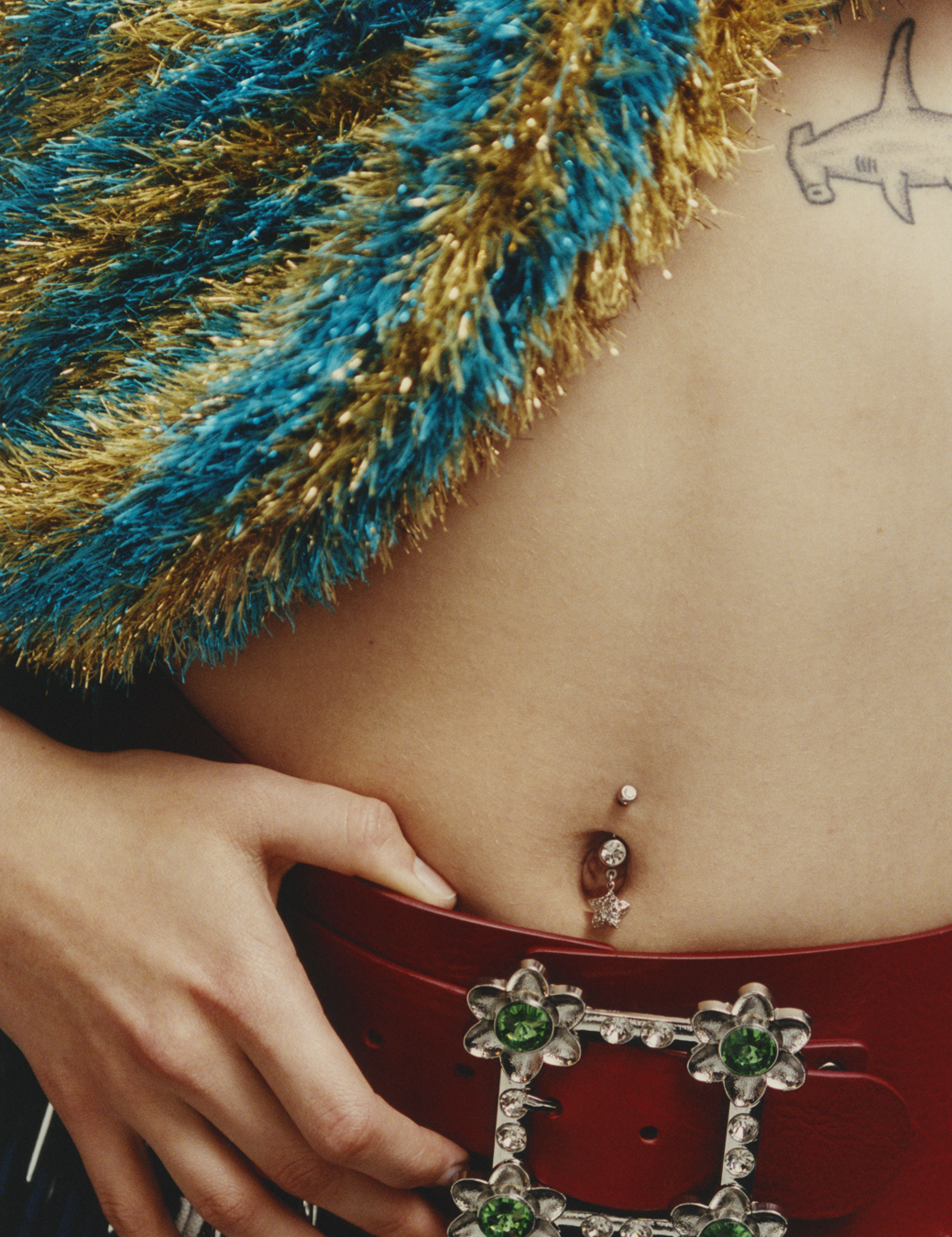
For an idea of who they are designing for now, look no further than their first-ever runway show, staged on the opening day of London Fashion Week back in September. It’s a week many in the global fashion community will remember for the fact that it was prefaced by the Queen’s death and the subsequent withdrawal of some of the schedule’s flagship names from the week. For those in attendance at the show, however, this was doubtless one of the moments they will remember it for. Staged in the art deco splendour of Porchester Hall in West London, it was walked by a motley crew of street- cast new faces and friends of the label, including Laura’s brother Harvey, designer Louise Gray, GUT Magazine’s Ami Evelyn Hughes, jeweller Georgia Kemball, and, well, yours truly. Keen to avoid casting the “traditionally modelesque”, Emma says, the pair tasked casting director Sarah Small with assembling a gang of characters that “looked like they went to the same school, but weren’t necessarily friends,” who embodied “an outsiderness, an awkwardness, a sense of discomfort,” she says. “And the walks! It was amazing.
It was all just so unique and fun and cool.” “You can see yourself in them as well,” Laura adds. “They’re all of us.” Rosy-cheeked and with hair set in Victoriana curls, dramatic tousles and trailing plaits, they stormed the runway to a high-octane mash-up of Bulgarian folk singing, lacrosse chants and thrash metal, wearing clothes that struck a similarly glorious visual cacophony. An austere overcoat in nightshade cloqué with glinting chrome hardware was followed by a lysergic tinsel vest; bows and ribbons tumbled down cotton crop tops, skirts and pouffe- sleeved gowns, flocked with black and scarlet floral motifs; cartoonish figures were scrawled across stretch lycra tees, tapestries of fawn-filled vistas became Bermuda shorts, and yes, there were lots and lots of carabiner- suspended skirts.

Reading that may sound like a lot to take in, and yet in a testament to Emma and Laura’s skill – not to mention that of their stylist Agata Belcen – the effect one was left with was of total cohesion; of beautiful, impeccably orchestrated chaos. It felt fresh, and that’s indicative of their status as a brand that has built itself outside of the infrastructures through which we typically view London’s young designers. The show was a vindication of the pair’s journey so far, and a triumphant celebration of having reached a point where they have “the confidence to do exactly what we want to do,” Laura says.
In a familiar turn of events, the institutions that had overlooked Chopova Lowena in its earlier days have now started to recognise their force. Proof of this came late last year, when Emma, Laura, and their team’s efforts were recognised with a nomination for the Independent British Brand category at The Fashion Awards. As proud of and humbled by the nomination as they were, it has not tempted them to mimic the operational strategies of the other nominees. In fact, it has only fuelled their confidence in their own convictions –such that, even after staging what was near-unanimously deemed a standout show of London Fashion Week SS23, they’ve decided not to show during the AW23 edition in February. “We were ready to do a show every season, but we realised that we shouldn’t feel the pressure to keep doing them just for the sake of it,” Emma says. “If we just want to do one show once a year – because that feels achievable and financially safer – then that’s exactly what we’re going to do. And it makes us more excited to build up to something.”

Emma and Laura’s adamant safeguarding of Chopova Lowena’s autonomy is what makes them embody fashion at its best. Yes, fashion is a commercial game that hinges on creating desirable clothes that people want to buy, but that isn’t where it begins and ends. Rather, fashion is a rare space where the aspects of yourself that you are ill at ease with can be used to create worlds that give a sense of comfort and belonging to others that feel just the same.
It’s a space where the weird and the esoteric become hallmarks of give-no fucks uniqueness; where outsider status, and the insecurities attached to it, become the foundations of enviable independence. That the path they have trodden has led Emma and Laura to success does not, however, mean that it’s necessarily one to follow. Thanks to brands like theirs, “the industry is changing,” Laura says, “and you can increasingly see that there are so many different paths to get where you want to get.” “I just hope that young designers who want to have their own brands can look at us and see that you don’t need to go through ‘the system’,” Emma concurs, “you can make your own way.”


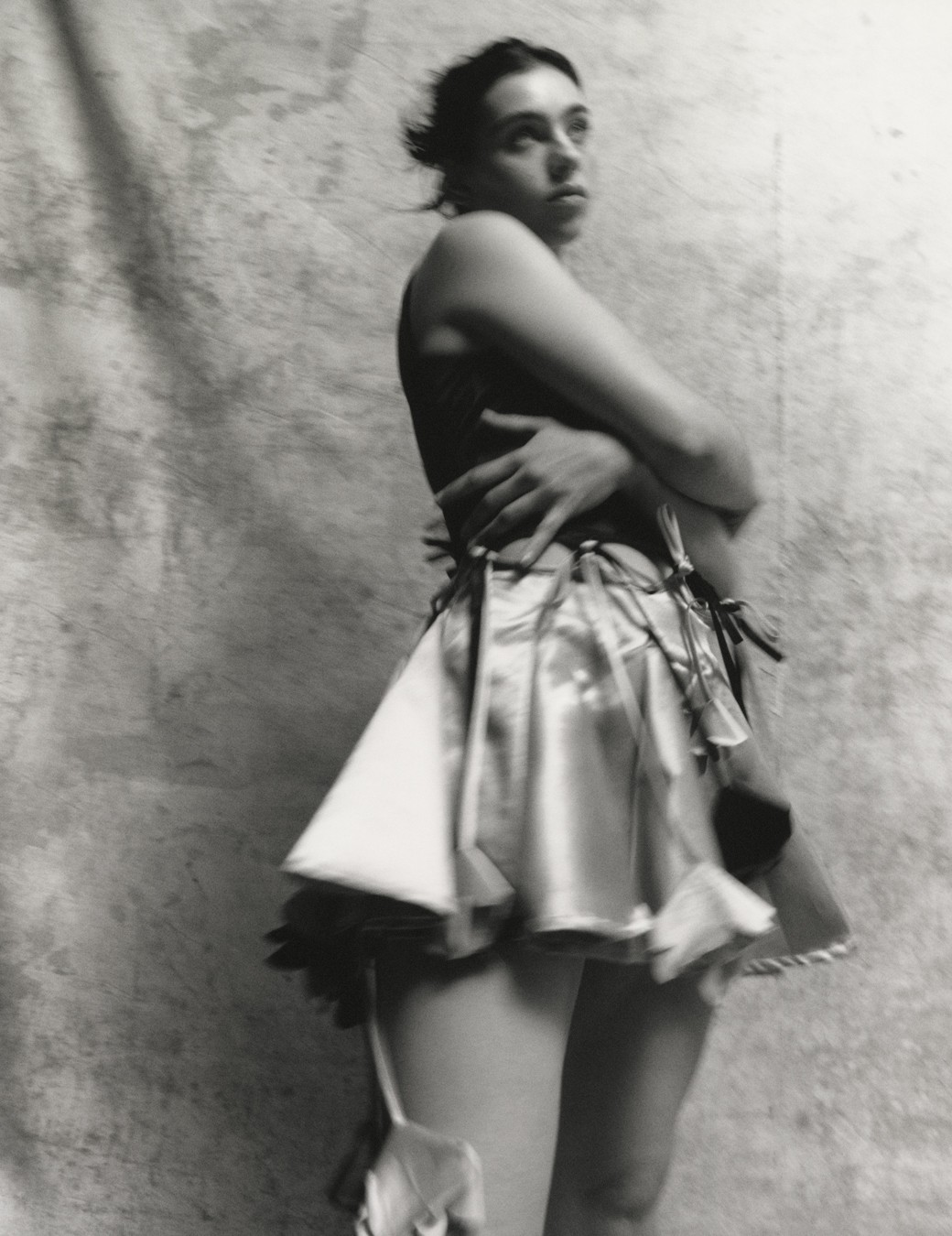
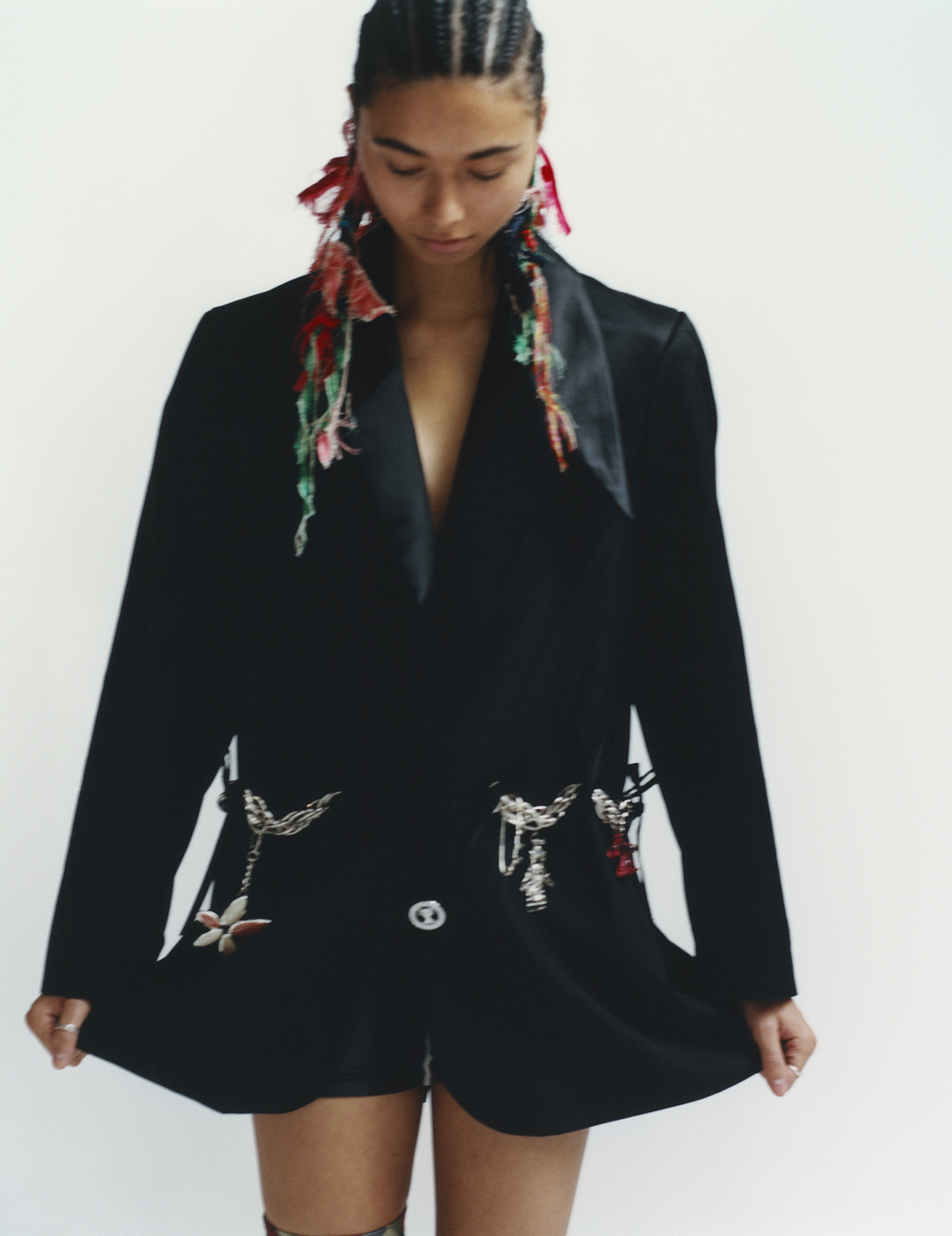

Credits
Photography Laura Jane Coulson
Fashion Bojana Kozarevic
Hair Kei Terada at Julian Watson Agency using Balmain Hair Couture
Make-up Crystabel Riley at Julian Watson Agency using de Mamiel
Nail technician Simone Cummings at CLM
Set design Roxy Walton at The Magnet Agency
Photography assistance Barney Couch, Oli Matich and Alia Romagnoli
Fashion assistance Marina de Magalhaes and Jade Wallace
Hair assistance Luca Pagani
Make-up assistance Simona Svantnerova and Temi Adelekan
Set design assistance Rafe Hamilton
Production CEBE Studio
Casting Lisa Dypmh Megens at Industry Art
Models Tatiana Con at W Model Management, Abi Asisa, Khžaikhysè y’Sohnt, Malena Papa Georgiou and Ruby Abidoph
All clothing and socks CHOPOVA LOWENA SS23
Jewellery (worn throughout) models’ own
